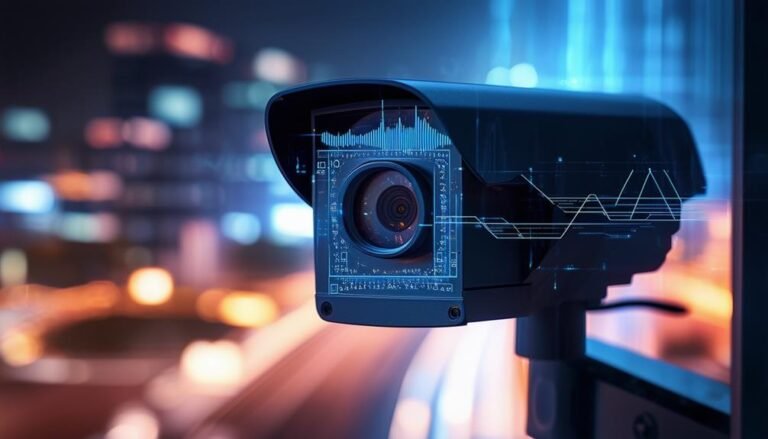To reset your Dahua DVR, start by exploring the main settings screen and selecting the gear icon. Look for the "System" or "Configuration" tab, then find the "Default" or "Restore Factory Settings" option. Confirm the reset action and wait for the DVR to restart. Alternatively, you can perform a hard reset by unplugging the unit, pressing the reset button while reconnecting the power cord, and holding it for about 10 to 15 seconds. After the reset, you'll need to go through the initial setup process. Keep going to uncover more details about optimizing your DVR settings.
Understanding Your Dahua DVR
When you're working with a Dahua DVR, it is vital to grasp its key features and functions. This understanding empowers you to make the most of your surveillance system, enhancing both security and peace of mind. The user interface is designed to be intuitive, allowing you to navigate menus, access live feeds, and review recorded footage with ease.
One of the standout features is the ability to customize settings according to your needs. You can adjust resolution, frame rates, and even set up motion detection alerts. This flexibility means you're not just confined to one way of monitoring your property; you can adapt your approach based on what you want to achieve.
The DVR also supports multiple channels, which means you can connect several cameras simultaneously. This capability is perfect for those who want extensive coverage without sacrificing quality. You'll find options for remote access, letting you keep an eye on things from anywhere, whether you're at home, at work, or traveling.
Understanding the storage capabilities of your Dahua DVR is equally essential. Knowing how much footage you can retain and how to manage that storage effectively will allow you to maintain a clear record of events. This is vital for ensuring that you've got the evidence you need when it matters most. Ultimately, a solid grasp of your DVR's functionalities sets the groundwork for a secure, well-monitored environment, giving you the freedom to focus on what truly matters.
Preparing for the Reset
Before you plunge into resetting your Dahua DVR, it's essential to gather a few important items and information. First, make certain you have access to your DVR and a monitor or TV it connects to. You'll need to see what's happening on-screen during the reset process. If you've got a mouse handy, that's even better, as it can make navigation a lot easier.
Next, jot down any necessary information like your current username and password. If you've forgotten these, it might complicate things later. You may also want to note down any specific settings you'd like to restore after the reset, such as recording schedules or camera configurations. This will help streamline your setup post-reset.
It's wise to confirm your DVR is connected to a stable power source. You don't want to risk a power failure mid-reset, which could lead to further complications. If you can, plug it into an uninterruptible power supply (UPS) for that extra layer of safety.
Lastly, consider backing up any significant data. If there's footage or settings you don't want to lose, make sure to save them externally before you start the reset. Remember, this process can wipe everything clean, so safeguarding what matters is essential. With everything in place, you're ready to move forward with confidence and reclaim control over your device!
Resetting via the Menu
To reset your Dahua DVR via the menu, start by steering to the main settings screen. You can usually get there by clicking on the gear icon or maneuvering through the options until you find "Settings." Once you're in, you'll want to look for the "System" or "Configuration" tab. This is where the magic happens, and you can take control of your device's settings.
After you've selected the right tab, seek out the "Default" or "Restore Factory Settings" option. This is your ticket to a fresh start. Click on it, and you'll be prompted to confirm your choice. Don't rush this step—make sure you're ready to wipe out your current settings. This reset will bring your DVR back to its original state, so any custom configurations or recordings will be lost.
If you're sure about this decision, confirm the action. You might see a progress bar or a message indicating that the reset is underway. Once it's completed, your DVR will restart automatically. After this reboot, you'll have a clean slate to set things up just the way you like.
Hard Reset Method
For those situations where the menu reset isn't an option or your DVR isn't responding, a hard reset can be a more effective solution. This method involves physically resetting the device, which can help restore it to its factory settings. Before you get started, make sure you've backed up any important data, as this process will erase everything on your DVR.
To perform a hard reset, begin by unplugging the power cord from the DVR. You'll usually find it at the back of the device. Wait for about 30 seconds to a minute; this allows any residual power to dissipate. Once the time's up, locate the reset button. It's often a small, recessed button that may require a pin or paperclip to press. Depending on your model, this button could be on the back or bottom of the DVR.
While holding the reset button, plug the power cord back in. Keep holding the button for about 10 to 15 seconds until you see the DVR's lights flash or hear a beep. This indicates that the device is resetting. After releasing the button, allow the DVR to boot up completely. This may take a few minutes, so be patient. Once it's ready, your DVR should be back to its factory settings, free to be set up anew. Embrace the freedom of a fresh start and enjoy configuring it to your preferences!
Post-Reset Setup Steps
Setting up your Dahua DVR after a reset can feel like a fresh start. You're now in control, and it's time to configure your device to suit your needs. First, connect your DVR to your monitor using an HDMI or VGA cable. Power it on and wait for the boot-up process to complete. You'll be greeted with the initial setup wizard, guiding you through the essential configurations.
Begin by selecting your preferred language. This choice makes maneuvering through the menus easier. Next, set the date and time—accurate timestamps are critical for your recordings. Don't forget to adjust the time zone to make sure everything's in sync.
After that, you'll want to configure the network settings. Wired connections are typically more stable, but if you're going wireless, make sure you input the correct Wi-Fi credentials. This step is essential for remote access and notifications.
Now, it's time to set up your recording preferences. Choose the resolution and frame rate that best fit your needs. You can also decide on the recording schedule—whether continuous, motion-triggered, or on a specific timetable.
Frequently Asked Questions
Will Resetting My Dahua DVR Delete All Recorded Footage?
Imagine you're a homeowner who's just had a break-in. You've been relying on your DVR for evidence, but now you're wondering if resetting it will wipe all that essential footage. Generally, resetting your DVR can indeed delete recorded files, erasing your security history. So, before you take that step, consider backing up your recordings if you want to keep your peace of mind and maintain a record of any past incidents.
Can I Reset the DVR Remotely?
Yes, you can reset your DVR remotely, but it depends on the specific model and settings. Most modern DVRs have remote access features that allow you to manage settings from anywhere. Just make sure you're connected to the internet and have the right permissions. Keep in mind though, resetting might affect your recordings, so double-check what you want to do before proceeding. Always prioritize having your data backed up for peace of mind!
What to Do if My DVR Won't Turn On?
If your DVR won't turn on, there are a few steps you can try. First, check the power source and verify it's plugged in. You might want to try a different outlet or power cable. If it still doesn't respond, look for any signs of damage or overheating. Additionally, consider resetting it by unplugging it for a few minutes. Finally, if nothing works, contacting customer support could be your best option.
How Often Should I Reset My Dahua DVR?
You might wonder how often you should reset your DVR. Generally, it's best to reset it when you experience issues like freezing or lagging. However, frequent resets can indicate deeper problems. Instead of resetting on a schedule, monitor its performance. If it's running smoothly, there's no need to reset. Trust your instincts, and only reset when necessary to maintain that freedom and ease in managing your surveillance system.
Is There a Warranty on My DVR After Resetting?
When it comes to warranties, resetting your DVR typically doesn't void it. Most manufacturers, including Dahua, offer warranties that cover defects and malfunctions, regardless of resets. However, it's always wise to check the specific warranty terms for your model. If you're unsure, contacting customer support can clarify any concerns. Remember, keeping your receipt and documentation handy is essential for warranty claims, so you're prepared if you ever need assistance.



